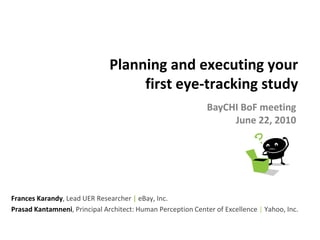
Planning your first eye-tracking study
- 1. Planning and executing your first eye-tracking study BayCHI BoF meeting June 22, 2010 Frances Karandy, Lead UER Researcher | eBay, Inc. Prasad Kantamneni, Principal Architect: Human Perception Center of Excellence | Yahoo, Inc.
- 2. Agenda • When is eye tracking useful? • The top 5 things I learned… • Q & A discussion
- 3. About us… Frances Karandy Prasad Kantamneni • Recently, joined as Lead • Principal architect of the eye- UER Researcher, BEX (2010) tracking platform at • Formerly, Staff Researcher, , • Has run dozens of eye tracking AdUx, Applications & Platforms tests for multiple Y! products (2005-2010) across the globe • Has run a few eye tracking studies
- 4. So, when is eye tracking useful? • To bridge gaps between behavioral and qualitative data • For obtaining information that is normally difficult to get from participants • For providing an accelerated learning curve in a domain
- 5. Top 5 things I learned in my first study… 1. Planning will define your success 2. Focus on the models, not the details 3. Think iteratively on hypothesis and study approach 4. Corroborate your study with other studies –powerful when done right! 5. Don’t expect to get it right the first time, or the second…
- 6. Planning will define your success • A fly without wings cannot hear! – Think of the principles driving behaviors
- 7. Planning will define your success • Illusion of functionality is important – Level of functionality or fidelity needed depends on your question • Test for contrasting conditions • Consider natural vs. canned tasks – Bar increases as you get closer to launch!
- 8. Focus on the models, not the details • Eye-tracking is extremely effective in building mental models – Step back to get the bigger picture – Even if you have specific study objectives, larger context will provide rationale for details and actions – You may generate a whole new set of insights, or research questions…
- 9. Think iteratively on hypothesis and approach • Take a data-to-theory (inductive) approach – Start out with initial hypotheses – Use the data to organically inform, change, and narrow your hypothesis • Think in terms of series of studies to allow for stimuli refinement • Set expectations upfront with stakeholders to plan for additional resources (time, participants, etc.)
- 10. Corroborate your study with other studies • Eye tracking is not a good standalone source of truth • Must triangulate this data with other methods and proof points – What one participant says → across other participants – What you are observing in the data → supported with theory – Aligning eye tracking results → established findings from qualitative , quantitative and/or behavioral data • Thoughtful planning, execution, and analysis can lead to dramatic improvements in the user experience and revenue in a very short period of time!
- 11. Don’t expect to get it all right the first time… • Give yourself extra time and the room to develop skills! – If something can go wrong it will – Learning curve is not the same as e.g., usability testing – As a manager, give your reports the time to learn …or even the second! • Don’t over generalize findings and observations, or you may risk credibility
- 12. Discussion | Q & A Frances Karandy, fkarandy (at) ebay.com Prasad Kantamneni, kprasad (at) yahoo-inc.com